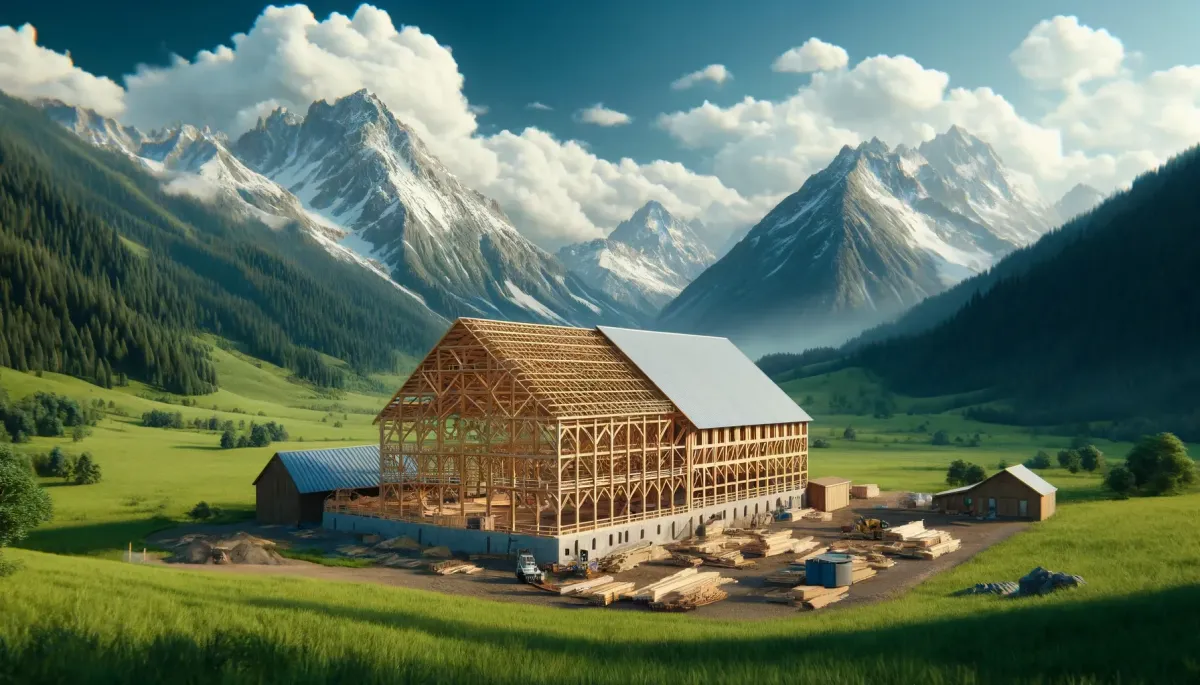The Benefits of Building a Barn or Garage in Park County
Building a barn or garage on your property in Park County is not just a practical decision; it’s an investment that can enhance the functionality, value, and aesthetics of your land. With the wide range of options available, including storage, workshops, and living spaces, the possibilities are nearly endless. However, navigating the challenges of designing structures for Park County’s unique conditions—such as snow loads, wind loads, and zoning ordinances—can be daunting. Whether you’re a homeowner, rancher, or outdoor enthusiast, adding a well-designed structure can transform your property and simplify your life. Here are some key benefits and considerations to help you get started.

Practical Uses for Your Barn or Garage
Storage: Protect your vehicles, equipment, and outdoor gear from Park County’s variable weather, including heavy snow and high winds. A dedicated storage space helps extend the life of your investments.
Workshops: Whether you’re a craftsman, mechanic, or hobbyist, having a dedicated space to work on projects provides convenience and efficiency. A workshop keeps tools and materials organized while allowing you to focus on what you love.
Living Spaces: Barndominiums or barn-to-living-space conversions are increasingly popular. These versatile structures can provide guest accommodations, rental income opportunities, or even a primary residence with rustic charm and modern functionality.
Animal Housing: If you’re a rancher, barns provide shelter for livestock, horses, or poultry, ensuring their safety and comfort year-round.
Multi-Purpose Flexibility: Many clients opt for hybrid structures that combine storage, workspace, recreational, and living areas. Customizing your barn or garage to fit multiple needs ensures you get the most value from your investment.
Deciding on the Right Size
Choosing the correct size for your barn or garage is crucial. Consider:
Your Needs: How will you use the space? For storage, measure the items you plan to store and allow for future needs. Workshops may require space for large tools or vehicles.
Expansion Potential: Think long-term. If you anticipate growing your equipment inventory or needing additional workspace, planning for expansion now can save costs later.
Zoning Regulations: Local ordinances in Park County may restrict the size or height of your structure. Always verify zoning requirements before finalizing plans. You can find the park county zoning ordinances on their website here: https://www.parkcountyco.gov/183/Planning-Zoning
Land Characteristics to Consider
Park County’s diverse terrain presents unique challenges and opportunities. Keep these factors in mind:
Rocks and Soil: Rocky soil may require special equipment or engineering for a stable foundation.
Trees: Trees can enhance privacy and aesthetics but may need to be cleared for construction.
Slope: Steep slopes might necessitate grading or retaining walls, impacting construction costs.
Access: Ensure your barn or garage location is easily accessible by vehicles, especially during winter.
Drainage: Proper drainage is essential to avoid flooding and foundation issues.
Checklist: Planning Your Ideal Barn or Garage.
Use this checklist to kickstart your planning process:
Define Your Purpose: When planning your barn or garage, begin by identifying its primary purpose and considering how it will fit into your property’s overall functionality. Will it serve as a dedicated storage solution for vehicles, tools, or seasonal equipment? If so, think about the size and type of items you need to store and any organizational features that might be helpful, such as shelving or racks. If you’re planning a functional workshop, consider the space required for tools, machinery, and work surfaces. For those interested in living quarters or a multi-purpose design, think about future uses, such as guest accommodations or even rental income. Additionally, a well-designed barn or garage can significantly enhance your property’s resale value, making it a smart long-term investment. Taking the time to define your needs and potential future uses ensures the structure not only meets your current goals but also adds lasting value to your property.
Assess Your Land: When evaluating your site, consider the impact of rocks, trees, slope, and drainage on your project. Rocky terrain may necessitate special foundation work, while existing trees can either enhance your property’s aesthetics or need removal to make way for construction. The slope of the land will influence grading requirements and drainage planning, both of which are crucial for ensuring the longevity and stability of your structure.
Confirm that your site is accessible for vehicles and construction equipment, especially during construction. This includes considering seasonal access issues, such as snow in the winter or muddy conditions in the spring, to ensure a smooth construction process.Research Zoning Requirements: Research local ordinances thoroughly to understand restrictions on size, height, setbacks, and other potential building requirements that may impact your plans. These regulations often vary by location and can significantly influence the scope and feasibility of your project. For instance, setback rules may dictate how far your barn or garage must be from property lines, while height restrictions could limit design options. Additionally, you may encounter guidelines on exterior aesthetics or environmental impact assessments, particularly in areas with unique ecological concerns. Taking the time to navigate these requirements upfront can save both time and money while ensuring a smoother approval process.
Set a Budget: When planning your budget, it is essential to consider all major components such as design, engineering, materials, labor, and permitting fees. Additionally, setting aside a contingency budget for unforeseen expenses, such as weather delays or material price increases, can safeguard against unexpected setbacks. Proper financial planning not only ensures a smoother construction process but also minimizes stress by providing a realistic framework for your project. With a comprehensive budget in place, you can focus on bringing your vision to life without the worry of hidden costs derailing your plans.
Choose Materials: When selecting materials for your barn or garage, you can choose between rough-sawn lumber and nominal lumber, each offering distinct advantages. Rough-sawn lumber delivers a timeless rustic aesthetic, making it ideal for clients seeking a traditional or vintage appearance. Its unique texture and natural appeal can enhance the overall character of the structure. On the other hand, nominal lumber is a more budget-friendly and practical solution that doesn’t compromise on durability. This option is particularly suited for projects where cost efficiency is a priority while maintaining structural integrity. Considering your design goals, budget, and intended use of the structure will help you decide which material aligns best with your vision.
Design Considerations: Thoughtful design is crucial when planning your barn or garage. Pay attention to the exterior elements, such as siding materials, color schemes, and roofing options, to ensure the structure complements your property’s aesthetics. Consider the interior layout, including the placement of walls, storage areas, and functional spaces like workbenches or lofts. Doors and windows are essential for functionality and natural light; their size and positioning can significantly impact usability. Additionally, the foundation type and roof design, including slope and materials, are key factors that affect the durability and overall look of the structure. By addressing these considerations early, you can create a barn or garage that balances form and function.
Plan for Utilities: When planning your barn or garage, consider whether you will need electricity, plumbing, or HVAC systems. These utilities often require licensed professionals to ensure safety and compliance with local codes. For electrical work, a licensed electrician will design and install wiring, outlets, and lighting, ensuring everything meets code requirements. Plumbing for water access or drainage will necessitate a licensed plumber, who can also help integrate systems like sinks or bathrooms. If heating, cooling, or ventilation is part of your plan, a licensed HVAC technician will ensure your system is efficient and properly installed. Factoring in these services during the planning phase helps avoid costly adjustments later and ensures your structure is fully functional from the start.
Consult a Professional: Work with a licensed contractor who is deeply familiar with Park County’s unique building requirements and equipped to handle your project from start to finish. A professional contractor like The Outfit can not only pull the necessary permits but also coordinate every aspect of the build, ensuring compliance with local codes and regulations. With expertise in managing licensed professionals, including electricians, plumbers, and HVAC technicians, we streamline the process and provide you with a worry-free construction experience. From initial planning to the final touches, partnering with a licensed contractor ensures your project is executed smoothly and meets the highest standards of quality and safety.
Why Choose The Outfit for Your Project
At The Outfit, we specialize in designing and building custom barns and garages tailored to your needs. From helping you navigate zoning ordinances to ensuring your structure can handle Park County’s snow and wind loads, we’re here to guide you every step of the way. Let us help you bring your vision to life with craftsmanship, quality, and unmatched attention to detail.
Ready to get started? Contact us today for a free consultation and let’s build something extraordinary together.
Welcome To

